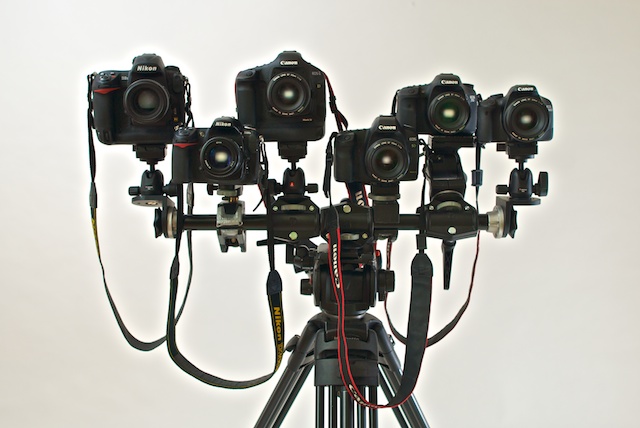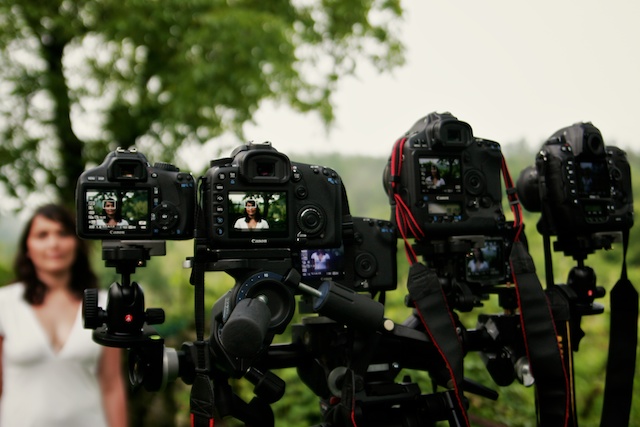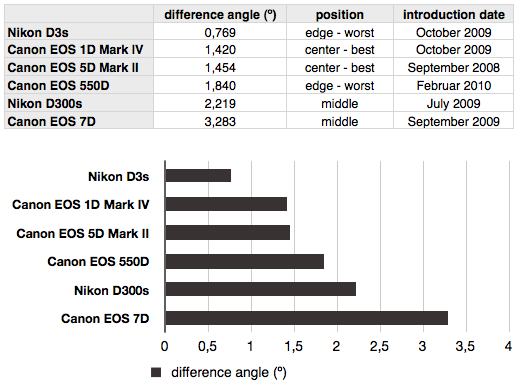I finally come around to piecing together part of some old tests I did last year. Part of my big DSLRs test, comparing Canon EOS 550D, Canon EOS 7D, Canon EOS 5D Mark II, Canon EOS 1D Mark IV, Nikon D3s and Nikon D300s all with 50mm lens on the body, was rolling shutter. I had the rig with which I could simultaneously record with six cameras so it was perfect for that kind of testing.

Rig for simultaneously recording with six DSLR cameras.
This is the rig I had made from various Manfrotto parts. You can read more about the rig here. But I think you can see the rig more clearly on this photo. (:

Beautiful Maja posing with seven, err, six bodies.
You can probably see that as I was turning (rotating) the rig, the cameras moved with different speeds. The ones closer to the center of the rig moved slower and ones on the edge moved faster, but the angular velocity was the same for all bodies. I am no physicist so I can’t tell you if that was influencing the strength of rolling shutter jello effect. If it has it is important to notice that Nikon 3Ds and Canon EOS 550D were moving the fastest, than Nikon D300s with Canon EOS 7D and cameras closest to the center, Canon EOS 1D Mark IV and Canon EOS 5D Mark II, had the best conditions i.e. the least movement.
My friend Maja was kind enough to be the model for the shoot as it was part of many tests and also a possibility to make a short movie out of them. You can see more photos of lovely Maja in my previous post.

Setting us all different cameras was quite a pain (©2010 Dino Schreilechner).
Setting up all cameras to shot the same thing was no easy task as I had to set exposure, framing, focus on all of them. Even just pressing record was difficult. At least on Canon cameras, because they don’t have any similarities between them. Record button is placed differently on almost every Canon camera. Even the button for Live View is not the same on different models. Some have dedicated button, some doesn’t. Nikon is so much user friendlier in that regard as it has dedicated Lv button in the same place on both models. And the start/stop button is the set button on the dial on both of them. But more on ergonomics in some later post.
This are the results that I got.
I measured the angle of an edge of the building. Than I measured that angle again when the cameras were moving and got the difference angle. That gave me rolling shutter intensity.
So Nikon D3s has the least rolling shutter even though it had the worst position (if there are differences between edge and center position as stated above) together with Canon EOS 550D who is not much behind the 5D and 1D who had the best position. I would say that if they were on top of one another they would have the same distortion or the 550D would be even better. I think this is due to age of the model, 550D being the youngest. Canon EOS 7D was surprisingly the worst even though it had the best position and the body being relatively new model.
You can see rolling shutter in effect in the next video. First are all the cameras placed sequentially and in the last shot you can see them in sync as a 6-up display.
Rolling shutter – DSLRs comparison from Peter Prevec on Vimeo.
You decide which you like best. I personally think that they are all horrendous and not useful for fast panning shots.
I would like to thank everybody who supplied me with the needed equipment: Nikon Slovenija (Nikon 3Ds, Nikon D300s, AF-S NIKKOR 50mm f/1.4G), Samo Vidic (Canon EOS 5D Mark II, Canon EOS 1D Mark IV), Foto Format (Canon EOS 550D, Canon EF 50mm f/1.4 USM), Luka Stanovnik (two Canon EF 50mm f/1.4 USM lenses) and my father Milenko Prevec (Canon EOS 7D, Canon EF 50mm f/1.4 USM).
I would also like to thank Maja Mesojedec for being such a patient model and Dino Schreilechner for helping me with the test and taking some behind the scene photos.
If you liked the story, please consider helping me maintain this blog by purchasing your gear through my product links. It will cost you nothing but will allow me to continue writing. Thank you!


great job
Thanks for taking the time!
I don’t think this test is accurate. With your setup, the cameras on the outside will move faster than the ones closer to the middle (the pivot point) when you pan quickly. The only true way you could accurately do this test is to stack them all on top of each other.
I was going to post the same as Ben about the outside cameras moving faster: angular velocity is the same for all of them, but that’s not the case with tangential velocity, which is what actually matters in this case.
Another issue I see is that on the crop cameras, the FOV is not the same: 50mm gives us the FOV of about 80mm, and I’m not sure, but that could affect the perceived angle of the rolling shutter.
What could be done is to let the cams stay on the tripod, and have some object quickly traveling along the frame. Could be a motorbike with some vertical flagpole attached, or anything else.
I have to say I partly agree with both of you as I stated in the paragraph under the second photo (maybe my beautiful assistant distracted you too much :) that you didn’t noticed it) that cameras moved with different speeds and also noted which cameras had better position in the rig and had at least tried to acknowledged it in the final thoughts.
But I wouldn’t agree on a importance of field of view (FOV) because I measured the angle of the skew which would probably be the same regardless the different FOV. But then again I am no physicist and I could be wrong.
But yes, the test would be more accurate with camera directly one over another or even traveling object causing the artifacts as Daniel noted in the comment.
Thanks for the thoughts!
ahahaha what a stupid rig, just put them vertically next time!
Since I have a 5D, I can’t seem to get any useful information from this test unless it is to say that it is the only camera that produces an image that is to blurry to be used while any other camera is OK.
Interesting, but not a deal breaker for me as I wouldn’t be panning like that even if the camera was up to the task.
I also would have liked to see the test repeated with the cameras in reversed positions to see if the results still held up.
As a novice, I did not know what a “rolling shutter” was. Good article on wiki,
http://en.wikipedia.org/wiki/Rolling_shutter
I must admit I was thoroughly distracted by Maja to really look for the shutter movement effects.
Please correct me if I’m wrong, but the time you have to be worried about this stuff is, when in video mode, when you pan quickly, or shoot when you or the subject are moving FAST… such as video at a sporting event like basketball or auto racing.
Can you compensate for this by changing your frame rate?
Also, with the Canon 5D Mark II, when shooting stills, are you using a rolling shutter or a global shutter? Or is that a silly question?
Thanks, John C
@John True. Fast panning or moving objects are problematic when shooting with CMOS sensor.
As I know frame rate doesn’t help.
When shooting stills you are using mechanical shutter so there is no rolling shutter artifacts.
Thanks for engaging in the conversation.
P!
beautiful bodies!